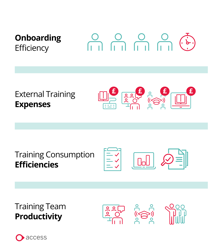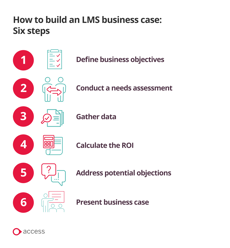How to build an LMS business case
The landscape of work has shifted, driven by rapid technological advancements and evolving employee expectations. Instead of L&D simply being a function within an organisation, it is now a strategic partner and a key driver across the employee lifecycle.
To keep up with this change, organisations must transform their approach to learning. This begins with a strategic investment: a Learning Management System (LMS) that empowers employees to take ownership of their learning, ultimately driving business success.
In this blog post, we will guide you through the process of building a robust business case for your LMS implementation.
In this article we are going to explore:
Creating an LMS business case: What to consider
If you’re working in the L&D space, you undoubtedly understand the importance of a sophisticated learning management system and the ways it can empower your employees. If you’re looking for a more powerful system or don’t have one to begin with, doing the research will likely show you just how beneficial it will be.
However, key decision makers within your organisation may not be as easy to convince. When it comes to budget restrictions, specific figures and cost savings need to be discussed and proven. An LMS business case will help to present this information in a way that is factual and easy to understand.
With this in mind, let’s look at 3 key points to include
1. Presenting facts and figures:
Implementing an LMS can yield substantial cost savings and productivity improvements by streamlining training processes and automating administrative tasks. Additionally, it facilitates personalised learning plans, real-time notifications, and remote access, resulting in efficient and effective learning experiences. Highlighting this as a starting point will showcase immediately that an LMS can bring the organisation value.
2. Identifying Relevant LMS Key Performance Indicators (KPIs):
To demonstrate the potential ROI of your LMS investment, you need to be able to track and analyse key performance indicators. Consider incorporating the following LMS KPIs into your business case:
- Onboarding Efficiency: Predict the time and costs associated with onboarding new employees.
- External Training Expenses: Evaluate the expenditures related to outsourced training services and show possible reductions for transitioning to in-house training via an LMS.
- Training Consumption Efficiencies: Calculate the hours spent on mandatory training per year and estimate time savings through diagnostic assessments and learning pathways.
- Training Team Productivity: Assess the time spent on manual processes and administrative tasks by the training team, and set expected time reduction targets.
To further enhance these saving efficiencies and to make a stronger case for an LMS, consider assigning cost savings and calculating possible return on investment for the KPIs overall.
3. Selecting the Most Suitable Learning Management System:
Your choice of LMS will determine your ROI, as certain factors will influence how much impact this will have. Consider user experience, functionality and flexibility. If you are creating a business case for implementing a general LMS then these points may not be as important (but still worth bearing in mind), whereas if you have a specific LMS from one provider that you would like to use, then this information is key. They should be discussed with the provider to find out how their LMS works and ways it can benefit your business.
If you’re having trouble choosing a learning management system, we’ve put together a handy guide which will talk you through the relevant steps and considerations you need to think about.
When selecting your LMS, consider specific features within it, such as one which includes an AI-powered Learning Assistant. This inclusion will reduce administrative burden, provide key data in seconds and recommend personalised learning for employees. An AI-driven LMS will likely save your company money which can offer a significant competitive edge. Its strategic value should be clearly articulated in your business case.
You should also look to select an LMS that supports engagement with learners, capturing their attention and driving them to seek out their own learning opportunities.

If you’re having trouble choosing an LMS, we’ve put together a handy guide which will talk you through the relevant steps and considerations you need to think about.
6 Steps to develop your LMS business case:
Now let’s look at how you can develop your LMS business case.
These points are crucial when looking to get buy-in and organisational support from decision makers within the company. Below are 6 steps we recommend you take to help build a robust business case investing in an LMS.

Template for Building an LMS Business Case: A 10-point plan
When building a business case for implementing an LMS, it's important to structure your arguments and present the information clearly, whilst making your reasonings persuasive and easy to understand. Below is a template that can assist you in pulling your LMS business case together.
1. Executive summary
Your first step is creating an overview of the business case in the form of an executive summary which will be presented to the board/approvers. This should include:
- Summary of proposal (i.e. why are we doing this and what are the benefits)
- Why do we need this (and what happens if we don’t do this)
- Total cash impact and P&L impact
- Risk/opps (additional benefits and risks not included in the summary)
2. Introduction
Talk about your current learning efforts and how this is impacting your organisation. Include challenges and limitations which will then be solved with the new LMS. Explain why an LMS should be implemented and how it can help organisations create engaging learning experiences, master compliance and maximise efficiency.
3. Objectives
Your objectives should align with your organisation’s strategic priorities and address pain points that your current LMS (or lack of one) brings in driving workforce excellence through L&D initiatives Explain the need for a robust and efficient learning management system to address these issues and ensure compliance, address skills gaps, and develop a robust, retained talent pipeline.
4. Benefits
List the expected benefits of implementing a learning management system. Focus on both tangible and intangible benefits including cost savings, increased employee engagement, effective training, and enhanced compliance management. Provide relevant data and case studies where possible to support each of the points.
5. Scope and requirements
Specify the scope of the implementation. This includes target audience, number of users and desired features of the new LMS.
Desired features within an LMS could include:
- Customisable home screens for specific users
- Detailed reports to track user progress
- Certificates and badges to recognise the achievements of your learners
- An AI learning assistant to immediately answer queries and locate documents
Depending on your current system, you may also need to think about integrating previous data into the new system.
6. Cost analysis
A cost analysis should cover both upfront and ongoing expenses that will come with the implementation of an LMS. This can include costs relating to licensing, infrastructure, customisation, training and support. Compare these with the expected benefits that the new LMS will bring to predict the return on investment (ROI).
Find out more in our article which explores the cost of an LMS .
7. Implementation timeline
A high-level timeline will outline key milestones, deliverables and estimated timeframes. This needs to showcase the feasibility and practicality of the LMS implementation process. We have put together a handy article outlining the implementation process.
8. Risk and mitigation
Outline potential risks and challenges that may impact the success of the implementation. Propose mitigation strategies to reduce the effects. This will showcase your forward-thinking mindset to key decision makers and make them aware of not only potential roadblocks but how you plan to navigate them.
9. Stakeholder analysis
Document the key individuals or groups will be affected by the implementation process. Find out how they may influence the projects success, including concerns and interests. From here, you can develop a robust strategy which will engage with them and gain support throughout the implementation process.
10. Conclude
Summarise the key points of the LMS business case, making sure to talk about the benefits, objectives and expected ROI. Emphasise how the LMS implementation will align with the organisation’s overall strategy and the ways that it will positively impact employees.

Final thoughts on building an LMS business case
Building a business case for your LMS requires a comprehensive understanding of its potential ROI and alignment with your organisational objectives.
By including key details such as an ROI assessment, the importance of choosing the right LMS provider, suitable KPIs and showcasing the benefits an LMS will bring, you can get the right information to important decision makers and create a compelling business case.
If you follow the steps outlined within this article, you are more likely to secure the resources, approvals and funding to implement an LMS.
Manage your learning today!
There are many ways to find out more about Access LMS Evo and how it can drive workforce excellence and supercharge your teams.

Schedule a live demo
Relax and let one of our learning experts showcase the capabilities of Access LMS Evo and find out how it can transform your organisation.
Explore our market-leading LMS
Empower your teams by igniting a joy for learning, through our AI-powered LMS.

Speak to an expert
Chat with one of our learning experts and find out how Access LMS Evo can be tailored to meet the needs of your business, regardless of size.





